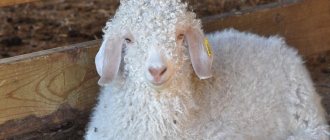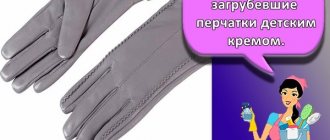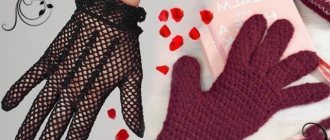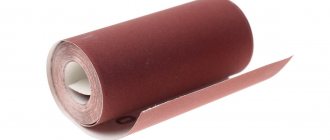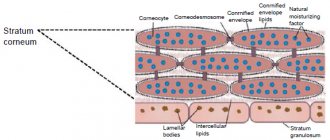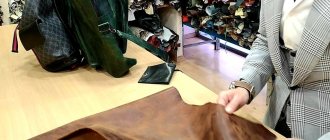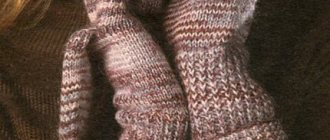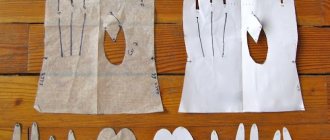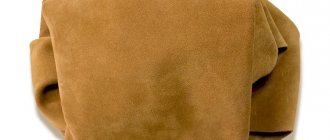Laika and kid gloves
Laika is a special type of leather from which gloves are mainly made. Let's figure out what is the secret of such popularity of this type of leather.
Laika is a specially tanned leather. In V.I. Dahl’s dictionary, husky is called “soft-made dog skin.” Who knows, maybe in Dahl’s time it was made from dog skin, but this method of dressing has come to us since ancient times.
In the leather industry, husky was made from the skins of kids and lambs, newborn or very young. This kind of leather dressing in English is called “kid”, which translates as “kid”. This once again confirms what exactly the husky was made of.
The Polish word "łajka" has the same meaning as in Russian. It is possible that dog skins were once used to make husky, but they certainly were not the main raw material for this type of leather. Therefore, we can definitely say that the name of one of the dog breeds and the name of specially tanned leather have nothing in common with each other.
How did you get such thin skin? Since ancient times, leather has been treated with a dough made from wheat flour, alum salt and egg yolk, or from alum, flour and fat.
Leather historians suggest that kid tanning has its origins in the Mediterranean, where it was perhaps invented by the Arabs, and then adopted by European countries. Laika began to be produced in Russia during the time of Peter I, but its production was established only in the 19th century.
The best grade of husky was made from the skin of kids, average quality - from lamb, and the lowest quality - from sheep skin. In the production of husky, the choice of raw material is extremely important, because the husky must be elastic, stretch perfectly and shrink back to its original shape. And on the front side of the husky there should be a glossy shine.
Today, antique kid gloves that we can see in a museum seem incredibly small to us. However, this only means that the husky can stretch perfectly. When fashionistas of that time pulled kid gloves on their hands, there was not a single wrinkle on them. Such gloves were sewn by hand, because a special machine, with the help of which products from husky were pressed so that the lines of their connections were completely invisible, was invented only in the middle of the 19th century.
Such gloves were put on with great difficulty; they did it at home, but in public such gloves were not removed. The best Russian producers of husky were the factory of the Bakhrushins merchants. In Russia, the building in which their factory was located was demolished.
The Bakhrushins also donated funds for the construction and even maintenance of various charitable institutions. In 1901, Alexander and Vasily Bakhrushin were awarded the very rare title of honorary citizens of Moscow.
Kid gloves can emphasize the elegance and sense of style of their owners and instill in them a sense of self-esteem.
How many years have passed since then, but kid gloves are still in fashion. Only the palette, length and styles have changed, and also the fact that now kid gloves can even be sewn by combining kid gloves with other materials. And as before, gloves are mostly made from husky. Laika is sometimes used to make jewelry. For example, sometimes kid leather is braided into bracelets. Another use of husky is the production of objects of decorative and applied art, for example, paintings or panels, because due to the fact that husky has the unique property of stretching well, it can be used to make magnificent draperies.
Laika can be made using chrome or chrome-fat tanning. Aluminum tanning is used to produce white, malleable and soft husky. The treated husky has a very smooth surface, without a single wrinkle.
Laika has low resistance to moisture. The main secret of its processing was taken from the recipes of the best tanners of the past, who, in order to soften the leather, added flour and yolk to it.
Until now, husky is one of the best types of leather, which is so loved by fashionistas for its beauty, elasticity and softness. And besides everything else, the husky is also very pleasant to the touch.
Did you see a mistake? Select it and press Ctrl+Enter
What kind of skin is there?
In order to know how to choose the right leather gloves, you need to know what they are actually made of. Signets today are made from different types of leather: sheep, goat, pork, deer. Each skin has its own characteristic features. More on this below.
Kid leather
Somehow it so happened that many people consider kid leather (that is, goat or sheep) leather to be the best leather for gloves. It is soft, smooth, tender and very pleasant.
In Russia, gloves made from such leather are almost never produced, and all because we do not raise goats and sheep in large quantities. But they are grown en masse in the UK and Italy. Most kid gloves are made there (and if not there, then from leather there).
Pigskin
Pigskin (compared to kid skin) feels thicker and rougher to the touch, but its characteristics are simply magical! It absorbs moisture well (including sweat) and at the same time allows the skin to breathe. In addition, pig skin retains heat very well. However, it is worth remembering that the rate of moisture absorption is both the strength and weakness of pigskin gloves. It is highly not recommended to wet such gloves too much, as as a result they can be severely and irrevocably deformed.
There are quite a lot of pigs, unlike goats and sheep, in Europe, so it won’t be difficult for you to purchase domestically produced gloves. However, Romanian pork skin is considered to be the best.
Deerskin
If you are wondering how to choose the best leather gloves, you should stop at products made from deer leather. This leather combines all the advantages of pork and kid leather: it is soft, elastic, quite thin and retains heat very well. Gloves made from this leather are elegant and durable. However, the pleasure comes at a price: deer will always be more expensive than pigs, sheep and goats.
Kind of kid leather and kid gloves
Genuine leather Genuine leather
is made from natural raw materials of animal origin: the skins of pigs, cattle, ostriches, reptiles and sometimes fish.
It is used in the production of shoes and clothing, leather goods and jewelry, in the production of furniture and decorative items. Slime
is the skin 0.5-1.4 mm thick of a stillborn calf.
Used to produce shoe uppers and clothing. Opoek
is elastic and soft leather made from the skins of calves less than 6 months old.
The outgrowth
is skin similar to the flange, but less soft and elastic.
It is produced from the skins of calves aged from 8 to 12 months and transferred to plant foods. The size of the outgrowth is 1.5 - 2 times larger than the aperture. Nappa
is a soft and thin semi-aniline leather made from sheepskin and cattle hides.
Napplak
is leather with a lacquered coating.
Most often it is lacquered nappa. Chevreau
is an elastic, soft, durable leather made from goat skins, made by chrome tanning.
It has a pattern on the front surface (merei) similar to small wrinkles. Chevrette
is made from sheep skins by chrome tanning.
It is similar in appearance and properties to chevro. Shagreen
- made from the dorsal part of the skins of cattle and horses.
It is rough and porous rawhide. Currently, “Shagreen” is produced from the skin of stingrays and sharks. Laika
is a thin, soft and elastic leather made from the skins of kids and lambs by chrome or chrome-fat tanning.
The surface of the measure is smooth, the thickness of the skin is the same from 0.3 mm. Laika is used to make kid gloves. Saffiano
is a soft and thin leather of bright colors, produced from vegetable tanned goat skins.
Nowadays it is almost never produced. Natural suede
is durable, soft, velvety leather with low, thick pile without shine, poorly absorbs moisture, made from the skins of elk, deer, and wild goats by fat tanning.
Deerskin,
nappa deer, chrome deer - elastic leather similar to suede, obtained by fatliquoring.
Used for the manufacture of folders, wallets, briefcases and other handbags and haberdashery products. Velor
is a thin, dense leather with a velvety surface, using the chrome tanning method, made from all types of hides (mainly with defects on the front surface).
Velor can be front or mesh, depending on which side was sanded with an abrasive cloth. Cheprak
is a dense, thick leather obtained from cattle hides by fat tanning, with a thickness of 2 mm.
Typically used for the production of shoe soles, belts, bags and other products that require high strength and density of raw materials. Shora
is a dense, thick leather obtained from cattle hides by fat tanning; it is more flexible than saddle cloth.
Yuft
- (yukhta) - thick leather obtained by fat tanning from cattle skins, which are taken from the belly of the animal.
It is more flexible and softer than blinders and saddle cloth. Split leather
(split leather velor) is leather obtained by splitting (burnishing) chrome and chrome-fat skins of pigs and cattle. According to the type of split leather, there are: front, mezdra (bakhtarmyan) and middle. The front split is stronger than the others, since one side is leather, the other is melon. Split wood is used in the production of haberdashery, footwear and clothing. When applying an artificial pattern, it imitates expensive types of leather.
How to choose the right size leather gloves
Choosing gloves of the right size is not so difficult; you just need to remember how this size is determined. It is determined by the girth of the palm “at the knuckles”.
Thus, standard women's sizes will be 19-20, men's - 23-25. This system of measures is international and common in Russia and Europe. However, some manufacturers calculate the palm circumference not in centimeters, but in inches (typical for Italy), and there women’s sizes range from 6 to 8, and men’s from 8 to 10. Converting from size to size is very simple, just remember that in An inch fits two and a half centimeters. And so that you don’t get confused with converting sizes back and forth, we have compiled a size chart for you.
| Dimensions in centimeters | 16 | 16.5 | 18 | 19 | 21 | 22 | 23 | 24 | 25 | 26 |
| Dimensions in inches | 6 | 6.5 | 7 | 7.5 | 8 | 8.5 | 9 | 9.5 | 10 | 10.5 |
Due to the use of different types of leather and different patterns by different manufacturers, glove sizes may vary in one direction or another, but no more than half a size.
Kid gloves: models, styles, colors
Surely, every person has heard the expression “kid gloves,” but not many know what kind of material is used to make this accessory. Because the word “Laika” for many people means a breed of dog.
Some confusion is also caused by the definition given in Dahl’s dictionary, which states that this is “the skin of a dog subjected to special dressing.” It is completely incomprehensible why the famous philologist decided to give such a definition. After all, the skin used to make huskies is not from dogs, but from kids and lambs.
What is Laika made of?
What animal is kid leather made from? The recipe for such a magical treatment of the skin of newly born kids was invented a long time ago, presumably by Mediterranean tanners. Leather, tanned using a special “dough”, which included alum, eggs, flour, and animal fat, was affordable only to the wealthiest people. Over time, the skin of newborn lambs was also used to make huskies.
Having learned the secret of kid leather and what animals it is made from, Europeans mastered its production. At first these were the trendsetters - the French, and soon after them the masters of the rest of Europe.
Story
History has not preserved the name of the person who invented the original method of tanning leather. For processing, tanners prepared a special “dough”, which included flour, egg yolks, animal fats, and alum solution. For the first time, leather, later called kid leather, was made in the southern regions of the Mediterranean. Then the production method was introduced in some European countries, including Russia.
To produce the highest quality huskies, the skin of goat kids , and very small ones, almost newborns, is used. Less quality is obtained when using lambskin as a raw material. And the lowest quality husky is made from sheep leather.
The choice of raw materials is very important, since the main quality of husky is its elasticity. If you look at kid gloves made in the 19th century (you can see them in museums), you will notice that the gloves are very small in size. And this is not explained by the fact that the hands of young ladies in the century before last were miniature. Kid gloves just stretch well, so to ensure a tight fit to the hand, gloves are made in small sizes.
Another property of husky is the glossy shine of the outer surface of the skin. Therefore, the gloves look extremely impressive.
For a long time, kid gloves were made by hand sewing. This was not an easy job, since the seams had to be quite thin, but strong and neatly processed. It was only in the 19th century that the production of kid gloves was mechanized. Special machines appeared that formed almost perfect seams without the use of manual labor.
Kid gloves were always expensive, but they were not very practical, since the thin leather often tore. Therefore, only very rich people could afford to have a supply of husky gloves. But they also tried to treat the accessory with care. Even young ladies from wealthy families sometimes had to wear mended gloves.
It must be said that, despite the elasticity of the skin, it was very difficult to pull on a kid glove so that there was not a single wrinkle. Maids helped young ladies at home, but outside the house (at a ball or reception) it was not customary to take off gloves.
How to determine the naturalness of leather
To know how to choose leather gloves, you need to be able to identify this very leather. Don't be fooled by the idea that you can recognize skin by smell or tactile sensations. Today's manufacturers have learned to make leatherette that looks and smells the same as leather (if not better).
So what should we do? Just don’t secretly try to set fire to a glove you haven’t purchased yet! The best way is to simply put your hand on the glove. Genuine leather will heat up, while artificial materials will remain cold.
It is also worth paying attention to the underside of the leather. There should be suede there.
Modern fashion
Of course, today you can see women’s kid gloves on someone much less often than in the 19th century. However, this classic accessory is still in fashion, albeit in a slightly modified form.
Gloves come in a variety of styles. Long kid gloves are most effective. This wardrobe detail can complement an evening look. In this case, gloves are worn with a sleeveless evening dress. A kid leather accessory will look especially impressive with a simple sheath dress.
Evening models of long gloves are usually made without lining, so they fit the hand quite tightly.
If you plan to wear gloves to protect against the cold, then it is better to choose a model with an insulating lining. Long models will look impressive with a raincoat, coat or fur coat with three-quarter sleeves. For outerwear with long sleeves, it is better to choose gloves of classic length - just above the wrist.
How to choose leather gloves?
Winter is over, and now spring is quietly but persistently knocking on every window, felt in the air, heard in the drops. It's warmer. It's time to take off your fur coats and take out your raincoats, hide your winter boots under the bed and take out your spring shoes, and also change your warm mittens for light leather gloves.
What? No gloves? Are the old ones torn? Tired of it? They don't look like a fountain at all? Then you urgently need to buy new ones! The site “Beautiful and Successful” will tell you how to choose leather gloves.
Why leather? Because there is nothing better than leather gloves for early spring. They fit snugly to the hand, retain heat well, do not restrict movement, and also look very stylish - there are only advantages all around!
Colors
The most practical option for kid leather gloves is black. Firstly, they go perfectly with clothes of any color. Secondly, black gloves are less likely to get dirty.
White kid gloves look very impressive, but every spot on them will be visible. And since kid skin does not tolerate exposure to water well, cleaning the gloves will not be easy. Therefore, white and simply light-colored models are chosen mainly as an addition to an evening or holiday look.
Modern designers offer not only plain kid gloves, but also printed models. For example, gloves with a “marble” pattern or leopard print are very popular.
As already mentioned, kid leather does not tolerate exposure to water well and requires special care.
It is recommended to clean stains that appear on the surface of light-colored gloves with gasoline. If you need to remove general dirt, you need to soak the gloves in clean gasoline for a couple of minutes, then remove them and clean them with a soft cloth. If you cannot remove the stains the first time, you need to repeat the soaking and cleaning process.
Then you need to carefully wipe the gloves with microfiber, sprinkle with talcum powder and leave to air dry.
It is not recommended to immerse dark gloves completely in gasoline, as the paint may partially discolor and streaks will appear. Places of contamination should be carefully wiped with a cloth soaked in gasoline and well wrung out. Do not sprinkle dark gloves with talcum powder.
How to choose leather gloves?
Once you have decided on the material, pay attention to the execution. It is believed that the best gloves are made in Eastern Europe (Romania, Hungary, Czech Republic), but, to be honest, good gloves can be made in any country.
Remember: good gloves a priori cannot be made from scraps of leather. No matter how attractive they are (and especially their price), remember that in two weeks (maximum!) they will look disgusting.
What should you pay attention to? The website sympaty.net draws your attention to three things:
It is very important that the leather is colored throughout its entire thickness. The color of the paint over the entire area of the glove must match (some differences in shades are allowed due to the characteristics of the leather itself).
There should not be too many seams, otherwise the glove will quickly lose its shape. It does not matter which seam (inner or outer) is used, it is important that it is solid, without skipping stitches.
And the last (but not least!) aspect of choosing gloves is the correct cut. Leather gloves do not stretch in length - they stretch in width (usually by 10-15 percent). A properly tailored glove is easy to put on and fits well on the hand, taking the shape of the hand and not restricting movement. After removal, the glove gradually returns to its original form.
Brands
When creating models of gloves made of kid leather, designers do not limit the flight of their imagination. On the catwalks you can see shortened models that do not reach the wrist, covering only the fingers. Victoria Andreyanova offers such original models of gloves made of kid. Of course, this option is not for a cold winter, but in a warm autumn it will allow you to create an original and stylish look.
Lanvin kid gloves have a classic length, and the designers use fringe to decorate accessories. Gloves from Rodarte are distinguished by their brightness; to make the models, the designers used leather in three colors, while the models are very thin, they fit the hand, literally, like a second skin.
What's inside?
When thinking about the question of how to choose leather gloves, you cannot ignore the reverse side of the product. In other words - the lining, and to be very precise, the lining material. It is believed that there are three types of suitable linings:
Linings made of synthetic material are considered extremely undesirable.
However, there is one “but” here. There is one such synthetic insulation called “thinsulate” (also called “thinsulate”, written in Latin as “thinsulate”), which has absolutely amazing properties. It retains heat very well, allows the skin to breathe, and is also completely hypoallergenic. In addition, it is very pleasant to the touch, reminiscent of flannel or flannel. It is often used to create clothing for the military and athletes. Now more and more often this material is used to create gloves. Therefore, a Thinsulate lining is suitable for you if you are wondering how to choose leather gloves for a long stay on the street.
History and features of kid leather production
Laika is a type of leather distinguished by a special alum-fat Laika tanning. According to references in written sources, alum tanning technology was used by the Arabs during the Middle Ages. However, it is believed that leather was first tanned this way in North Africa. In the 18th century, Hungarian craftsmen were invited to the French court and established the production of kid leather in France; from there, the alum tanning method spread throughout Germany, Poland, and then came to Russia.
In the middle of the 19th century, factories were opened in Russia for the production of kid gloves from greyhounds. With the decline of lordly hunting, entire kennels of greyhounds were sold to factories. The Russian name “laika” was borrowed from Polish and meant “fat, lard.” In common parlance, the material was also called “dog” due to the fact that it was produced mainly from the skin of dogs.
What is made from this type of leather?
Even 100 years ago, every noble lady and young girl was required to have several pairs of kid gloves in her wardrobe, which emphasized her high status. Now the production of this type of haberdashery has decreased significantly, but kid is still used for the production of gloves. They turn out to be very soft, thin, tightly fitting each finger. Such gloves are not worn in winter, because they will be cold.
Kid leather is also used for sewing bags and clutches. This material is easy to dye, so you can make bright colorful things from it.
Due to its high elasticity, husky leather is widely used in handicrafts. Various crafts are made from it (paintings, leather flowers), appliqués, and used to decorate clothes and hats.
The next industry in which husky is used is arts and crafts. Various jewelry is made from it: bracelets, cords for pendants, belts, woven beads.
Caring for kid gloves and bags
As mentioned above, the husky does not tolerate water. How, then, to care for kid products? It is recommended to use gasoline to clean gloves and bags.
A soft cloth is moistened in purified gasoline and the stain that appears on the surface of the product is gently wiped. If you need to clean the gloves completely or you couldn’t wipe off the dirt the first time, you can soak the entire item in gasoline for 5–7 minutes. Another way to clean a white husky is to rub it with a mixture of milk and turpentine.
After this, the item is taken out, gently wiped with a microfiber cloth and left to dry in the open air or in a well-ventilated area. It is forbidden to dry the item near heating devices or open sources of fire - this will hopelessly damage the leather. White gloves can be sprinkled with talcum powder.
What to do if the kid product gets wet? When dry, the skin becomes hard, rough, and may crack. To avoid damaging the item, it is recommended to lubricate the surface with oil. For these purposes, it is best to use castor oil or glycerin. Gently wipe the surface of the material with a cotton swab dipped in oil.
It is prohibited to store kid products in plastic bags. The skin must “breathe” and be ventilated, so it should be kept in bags made of natural fabrics.
Kid gloves and handbags are exclusive items that will add a touch of sophistication to any evening outfit. With proper care, this delicate material can maintain its beautiful appearance even after prolonged wear.
Price issue
First of all, you need to decide on the cost of the gloves. Today, gloves are sold everywhere: in special leather goods stores, and in clothing stores next to tights, and in underground passages along with Baba Lyuba’s pickles, and even in grocery stores. And, of course, prices for products are completely different everywhere. Surely you know that cheap is not always good. This rule applies here too. Leather gloves for 200 rubles simply cannot be good (or cannot be leather). At the same time, shelling out huge amounts of money for two leather rags is also unreasonable.
The optimal price is 1000-2000 rubles for a pair of gloves. If you suddenly think that this is a bit much, think about the fact that they will protect your hands (and, accordingly, you) from the cold for several years.
Kind of kid leather and kid gloves
Opoek is a soft, elastic leather obtained from the skins of suckling calves.
Outgrowth - leather, similar to fluff, but less elastic and soft, is obtained from the skins of calves that have switched to plant foods.
Nappa is a thin semi-aniline leather made from the hides of cattle.
Chevreau is a soft, dense, durable leather made from goat skins by chrome tanning. On the surface it has a peculiar pattern in the form of small wrinkles.
Chevrette is a thick, elastic leather made from sheep skins by chrome tanning. According to the pattern of the measure, it looks like a chevro.
Shagreen is a rough and porous type of untanned leather, made from the dorsal part of the hides of horses or kulans and usually dyed green. “Shagreen” these days is usually made from the skin of sharks and rays.
Laika is a soft, elastic leather made from the skins of lambs and kids using chrome or chrome-fat tanning. The surface of the measure is smooth, without wrinkles. Laika is used almost exclusively for making gloves.
Morocco is a thin, soft leather of different colors, made by vegetable tanning, usually from goat skins, less often - the skins of sheep, calves and foals. The secret of its production has been known in Russia since the 12th century. Currently not produced.
Natural suede is leather produced by fat tanning from the skins of deer, elk, and wild goats. This is soft, loose, but very durable velvety leather with thick, low pile on the front surface.
Deerskin is leather that is processed using fat extracted from animal brains or other types of fats. The end result is an elastic suede-like material, usually heavily smoked, which prevents cell decomposition. This type of leather is commonly used to make briefcases and wallets.
Velor - leather, using the chrome tanning method, is produced from all types of hides, it is leather with a polished front surface with an abrasive cloth (front velor) or with a polished mesh surface (bakhtarmy velor).
Cheprak is the configuration of raw hides, i.e. a skin without a floor or a collar. This type of product is usually used for leather for belts for both men and women, since this is the densest part of the leather.
Shora is a dense, thick leather produced by fat tanning from cattle skins; it is more plastic than saddle cloth.
Yuft is a thick leather produced by fat tanning from cattle skins taken from the belly of the animal. Significantly softer and more flexible than saddle cloth or blinders.
Yuft (yukhta, Russian leather) - made from cow or cow raw materials and the skins of one-year-old bulls, with the exception of veal raw materials. After washing and fleshing, the raw materials are subjected to ash, washing, trampling and kneading in pounding and drums, cutting, shavings, squeezing the face, boiling in jelly, soaking in weak tanning juice and then juice and powder tanning. Yu comes in white, red and black. The best leathers are selected for white Yu.
Split leather (split leather velor) is a layer of leather obtained as a result of lamination (shearing) of chrome and chrome-fat cattle and pig skins. Shoe and furniture leathers are made from thick and dense cattle split leather by applying artificial measure and velor split leather for the production of clothing. Split leather velor is made from split pig skins for shoe production.
Split is a layer of dermis obtained by splitting (dividing into layers) a semi-finished product in leather production. There are S. facial, middle and mezdrovy (or melon). Photo leather or haberdashery leather is produced from thin facial leather. Front leather, which is relatively thick, and medium leather are used to produce leather, which is used mainly for making shoes. Velor for shoes and clothing, as well as chrome-tanned leather for shoe uppers and Yuft, which have an artificial outer surface, are produced from melon leather. Fine S. and split edges (thin edges cut off) are used for the preparation of technical gelatin, glue and other collagen dissolution products.
Leather is classified according to purpose into the following types:
1. Shoe. Different for the bottom of the shoe and the top. The leather for the bottom is subjected to special tanning, often combined. The leather for the upper of the shoes is softer, chrome tanned or yuft.
